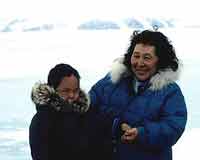About
The
Children
of Two Cousins
About
The
Children of
Two Cousins 2
About
The
Men From The Firth
Visiting The People At The Open SeaShore
Akigsiak
Aklaujak,
A
Tale From Labrador
Akutak
and
Inuinak
AMONG
THE
LAST ANGAKUT
AT KANGERDLUGSUATSIAK (Greenland)
Anarteq
Angakok
Flight
Angakok
On
Kekertarsuak
Angakorsiak
Was
Very Proud
Of His Angakok Wisdom
ÁNGÁNGUšJUK
Angutisugsuk
Angutisugsuk
Ver
2
Ankakumikaityn
the Nomad Wolf
Another
Tale
From
East Greenland
Arnarsarsuak,
The Kivigtok Woman
Artuk,
Who
Did All
Forbidden Things
ASALÔQ
Atalianguak
Atanarjuat
(the
Fast Runner)
Âtârssuaq
Atarsuatsiak
Atdlarneq,
The
Great Glutton
Aterfio
Aterfio
2
Atlunguak
Atungait,
Who
Went AWandering
Atungak,
A
Tale From Labrador
Augpilagtok
Auroras
Avarunguak
or
Agdlerut
Avatarsuak,
Who
Was Baptised
Nathan
Avigiatsiak
Being
still
at night
Creation
An
Inuit Tale
Creation
By
Women
Creation
Inuit
Deceived
Blind
Man
Dog
Husband
Eagle
Boy
Eagle
and
Whale Husbands
Fox
Woman
Encounter
of
Kaladlit with the
Ancient Kavdlunait on the Ice
Ernersiak
The
Foster-Son
Fog
Woman
Game
of
Ball: Legends and Folklore
of
the Northern Lights
Girl
Named
Isserfik
Girl
Named
Tuagtuanguak
Girl
Who Went Away
in Search Of Her Brother
Giviok

He
Man
Not To Be Looked
At By The Europeans
How
Anikunapeu
Took A Wife
How
Fox
Saved the People
How
The
Fog Came
Igimarasugsuk
Íkardlítuarssuk
Ímarasugssuaq,
Who
Ate His Wives
In
The
Beginning
Inuarutligak
-
Whose Christian Name
Was Peter Rantholl
Inugtujusok
Inuit
Prophecies
Isigaligarssik
Isigarsigak
Isigarsigak
And
His Sister
Iviangersook
Travelled
All Around
the Coast Of Greenland
Kánagssuaq
Kâgssagssuk,
The
Homeless Boy
Who Became A Strong Man
Kúnigseq
Kaassasuk
Kagsagsuk
Kagsuk
Ka-ha-si
and
the Loon
Kajortoq,
the
Red Fox
Kakortuliak
Kanginguak
Kasiagsak
Kasiagsak,
The
Great Liar
Katerparsuk
KATIGAGSE
Kigdlinararsuk
Kigutikak
Who
Was Carried
Off By The Whalers
Kiviuq
And
The Fox Woman
Kumagdlak
And
The Living Arrows
Kumagdlat
And
Asalok
Kushapatshikan:
the
Shaking Tent
Lamentable
Story
Lamentable
Story
2
Last
of
the Thunderbirds
Legend
of
the Aurora Borealis
Makíte
Malaise—The
Man
Who
Travelled To Akilinek
Malarsuak
Maminteu
Manik
Manitutshu
the
Spirit
Married
Couple
Remained Childless On Account
of Their Both Being Angakok
Moon
Story
Mountain at Muskrat Falls
Mashkussuts:
Bear
Cubs
Mishtamishku-shipu:
Giant
Beaver River
Manitutshu
the
Spirit Mountain at Muskrat
Old
Bachelor
Old
Man
Lost His Only Son
Old
Man,
Who Was Always Anxious
To Outdo Other People
Prophecies
Raven's Great Adventure
Swan-Maidens
Tale
About
Two Girls
Tale
From
East Greenland
Tale
From
Labrador
Visit
To
The Giants
Woman
Named
Alekakukiak
Woman
Named
Arnasugaussak
Woman
Who
Was Mated With A Dog
Youth
Who
Joined the Deer
 Return to Indigenous Peoples' Literature
Return to Indigenous Peoples' Literature